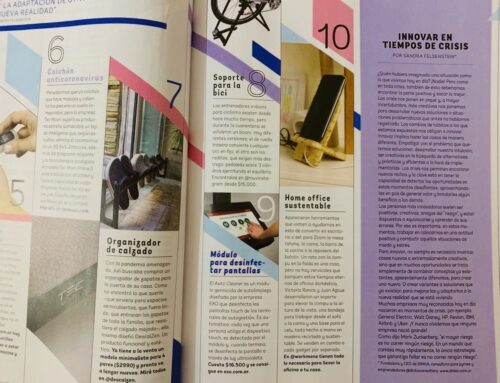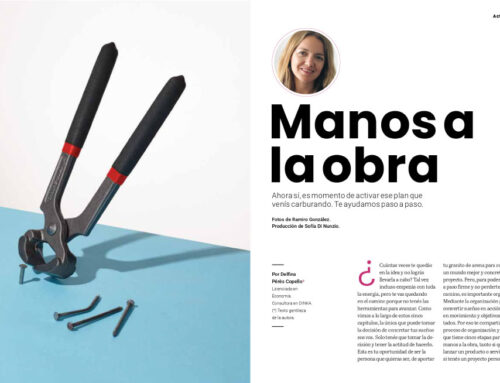Let's do it
Today's society is eager for ideas that have a notable impact. The great challenge is to put that thought into practice. How to achieve it?
You continually have ideas. All the time. But how is it possible to make them a reality? Although some of those dreams are plausible, sometimes it is difficult to make them come true. The defects are minor or enormous, but perhaps, by analyzing them in depth, they can be seen from another perspective and resolved.
Engineer Sandra Felsenstein shares the keys to bringing a venture to fruition: "I always recommend paying attention to the first steps, to try to increase the probability of success. It is essential to analyze both the viability of our project and make an economic forecast, since, probably, positive results will not be obtained immediately. What's more, in addition to how much to invest, we must estimate how we will solve negative periods."
From her experience as director of Dinka, a consultancy dedicated to comprehensive advice for SMEs – whether at the beginning of projects, as well as in their growth, development and professionalization –, Felsenstein believes that an exhaustive study must be carried out: that is, survey the market and understand in depth the tastes, behavior and preferences of potential clients. "What we have to try is to 'get into the minds' of the public we are targeting. A strategy and a commercial plan must also be drawn up, and a clear differentiation of the product or service that we are going to offer must be established, whether in terms of design, form of distribution or after-sales service," lists Felsenstein.
“We have to try to ‘get into the minds’ of the public we are targeting, draw up a commercial plan and differentiate the product.” Sandra Felsenstein
For her part, Cecilia Moloto, director of Women Who Undertake, a community that provides online training to help those who want to encourage themselves and live what they are passionate about, offers her view: "First of all, we must put the idea on paper: if we can explain it in two lines, it means that we are on the right track. Another aspect that we must take into account is the competition: what they sell and how they do it. From this, we can determine what our added value is, why "They will bet on us and not on the one in front."
In the technological era, everything that refers to choosing and managing communication channels takes on a major role. Disseminating is a sine qua non condition. One of the most favorable media for those who are starting out is Facebook. “Sponsored ads are a great ally when developing a dissemination strategy due to their low cost and easy configuration,” says Moloto.
To read and cheer up
Beyond the Idea is a book written by Vijay Govindarajan and Chris Trimble. Govindarajan was born in India and is a global strategy expert and leader. Forbes magazine included him on the list of the five most admired executive coaches on the planet, and The London Times considers him one of the most respected management thinkers. For his part, Trimble works at the famous Tuck School of Business, belonging to Dartmouth College. The book talks about the details and questions that can shake the desire for what you want to build. And they reflect on what arises from the birth of an idea: what should be taken into account, who to turn to and how to manage time.
"We have to put the idea on paper: if we can explain it in two lines it means we are on the right track. Another aspect: investigate the competition" Cecilia Motolo
Creativity and heart versus obstacles
Although it is not inherent to all human beings, creativity is a plus, an accomplice like few others for the metamorphosis of the idea. In her book Enhancing Creativity, which is part of the collection Tools for 21st Century Leaders, Clemencia González Silveyra emphasizes that, through this, the world is perceived from a different perspective, hidden patterns are discovered, connections are made between phenomena that are apparently unrelated, and solutions are also found.
According to the specialist in neuroscience and neurogames, it is crucial to put what we imagine "in motion": "Creativity involves going through two processes. The first is thinking + producing: if we have an idea, but we do not turn it into action, we could define ourselves as imaginative, but not as creative. Why? Because being creative is creating and creating is doing. The second process is innovating, which is the implementation of a new or significantly improved product or service that creates value.”
Of course, as the process begins to get underway, the inevitable problems may arise. Regarding them, Felsenstein details: "We can list the lack of experience, the lack of knowledge of the market, the lack of a solid team, the lack of capital to invest, the little training in any of the areas or the lack of the indicated contacts. Likewise, there are contextual factors, among which we can mention: tax burden, lack of financing, external policies and unfavorable regulations. Another obstacle that sooner or later appears is fear, which can paralyze us. Therefore, the more prepared we are, the more tools we will have to combat it.”
In the present, whether in the field of education or even in management, emotions prevail. The field of entrepreneurship is no exception. Motolo is clear and forceful: "Something very common is a lack of self-confidence. This is vital because if one does not believe in one's own project, why would one's potential clients do so? The shortage of people interested in the products or services offered is another point that can affect our will. Social networks are very useful to mitigate this shortcoming."
"Creativity involves going through two processes. The first is thinking + producing. The second is innovation, creating value." Clemencia Silveyra González
Values
Consistency, perseverance and open-mindedness to assimilate mistakes. Being the owner of an idea entails certain unavoidable, inalienable characteristics. "Dedication, tenacity, empathy - Felsenstein expands the list. And he continues -: To be a successful entrepreneur it is essential to have a lot of conviction. The ventures that work are those led by people who are very motivated and passionate about what they do. This way they will be able to transmit the same to their work team. Motivating others without someone to motivate us is a challenge that must be taken on."
Finally, there are two relevant items that should not be left aside. On the one hand, the innovative spirit. Once the idea is applied, the flame must be rekindled so that it does not go out. Regarding this, Felsenstein says: "You always have to listen. I like the following phrase: 'Nothing I'm going to say today is going to teach me anything. Therefore, if I want to learn something, I have to listen.' This famous sentence expresses one of the main messages that must be engraved in your head."
Secondly, the need to achieve heterogeneous teams emerges. To do this, individuals with unequal interests, ways of communicating and rhythms will have to be selected. And although before, differences could be perceived as possible generators of personal exhaustion, demotivation, low performance or high dropout, today the opposite is interpreted: dissimilarities can be taken advantage of in pursuit of optimal, enriching performance.
"Let's not forget the ability to observe. Aligned with the concepts that are being expressed, being able to attend meticulously encourages the birth of unpublished ideas. This goes hand in hand with a tireless search for learning, which involves attending courses, seminars, conferences, or following references on social networks," adds Felsenstein. Motolo agrees and concludes: "We have to prepare ourselves to absorb all the information that surrounds us. The entrepreneurial spirit and the possibility of having an innovative idea is promoted when we nourish ourselves with the space we inhabit. Inspiration can be found in fairs, talks and even in YouTube videos, but, above all, being in contact with those who follow our same journey."








